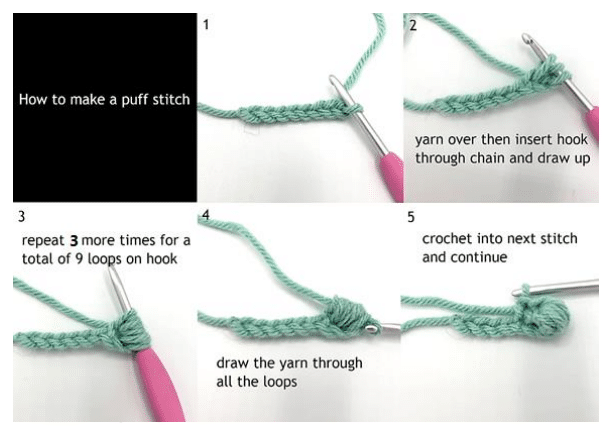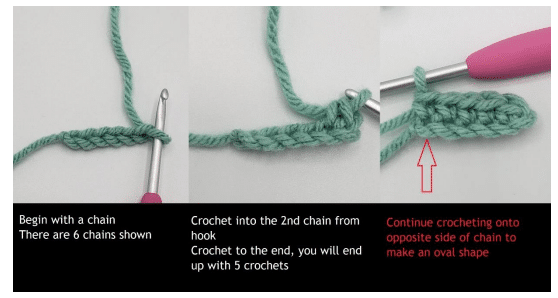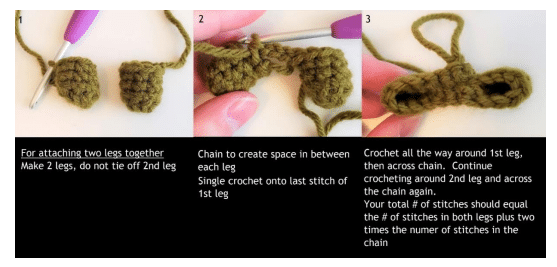If you have never crocheted before, NO PROBLEM. Everyone has to start somewhere. When I first started, it took me a week just to figure out how to make a ball. It took even longer to get my fingers and hands used to holding a crochet hook.
Crocheting can be frustrating at first but like with all things new, your body will develop muscle memory and over time, you will find that it will get easier. Always remember that nothing is hard, only new.
There is no right way or wrong
way to crochet. Whatever works for you, your body, and your ability is the right way. Some people will hold a crochet hook like a pen, I prefer to hold it like a knife, with my index finger along the length of the hook. This is purely personal preference. Crochet is an art form and like all art forms, is open to personal interpretation.
Crochet patterns function as guidelines only, and I encourage you to bring your own artistic flair to each pattern. Do not be afraid to use different hooks or types of yarn. Experiment by changing the colors. Add accessories, modify the body shape, and bring your own individual spice to each pattern.
Sometimes it will work; most of the time, it will not, and that is perfectly fine because in the end, you will end up with something that is yours. Something that you created. Your own little knotmonster.
HOOK, YARN, AND SINKER
Crocheting requires two fundamental things: a hook and yarn. Hook sizes are measured in millimeters and are also given a corresponding letter. For example, a 3.75mm hook is called an “F” hook and a 4mm hook is called a “G” hook. For amigurumi, I like to use a 3.75mm or a 4mm hook with medium weight yarn.
The smaller the hook, the tighter the stitches will be; the bigger the hook, the looser the stitches will be. The yarn is complementary to the hook. A thinner yarn will require a smaller hook, and a thicker yarn will require a larger one. Let’s talk about what else you will need.
To start, you will need:
- Hook [3.75mm (F) or 4mm (G)]
- Yarn (medium weight)
- Scissors
- Stitch marker (eg. scrap yarn, paper clip)
- Safety eyes (8-14 mm)
- Yarn needle #16 with blunt tip
- Stuffing material
- Pen/paper
Additional items:
- Ruler
- Hot glue or fabric glue
- Felt (multiple colors)
- Embroidery thread
Fabric scissors are specifically designed to cut fabric. They are incredibly sharp and will cut the yarn without fraying of the ends. This makes it much easier to thread the yarn through the needle when you are tying off.
Safety eyes are called “safety” because they have a small hole in the bottom of the eye. If a small child accidentally aspirates the eye, this hole will allow for air to pass through it.
This is the concept, but it is not fool proof. Always use caution when you are giving a toy to a child under the age of three or to a child who tends to put things in their mouth.
Alternatively, for these children, I would highly recommend making eyes out of yarn or felt instead. It is also important to thoroughly tie in your loose ends so your toys will not unravel and fall apart. Stitch markers can be purchased from any craft store or online.
Stitch markers help you keep track of where your first stitch in a row is. By marking your first stitch with a stitch marker, you will know when you have reached the end of your row. Alternatively, you can use a paper clip or a piece of scrap yarn (my personal favorite).
You want a needle that is wide enough to allow for medium weight yarn to pass through the eye, while small
enough to comfortably weave in your ends when you finish. A trick to easily thread your needle is to flatten the end of the yarn. 6 Accessories and pieces can be sewn or glued to your knotmonsters.
Whenever possible, sew the pieces on, as they will hold much better than glue. However, glue works great to attach felt eyes as long as they are thoroughly attached, including the edges. When sewing, I recommend using the mattress stitch technique in order to hide the stitch as much as possible.
For a mattress stitch, draw the yarn up one stitch and back down through the next stitch on the same piece. Then attach it to the other piece and repeat
HOW TO CROCHET
When you start a new pattern, the technique of crocheting will be noted as either completed in the straight or the round. Straight crocheting is completed in rows by going to the end of a row and turning around, creating a square-like pattern. Round crocheting is completed in rounds and, starting at the center, is done in spirals creating a circular pattern. Typically, a chain is used to start a straight crochet while a magic ring is used to start a round crochet. Exceptions to this are when an oval shape is desired. In this situation, you may form a chain and then, instead of turning at the end of the row, continuing onwards to the opposite side of the chain, thus creating an oval.
Patterns are written in different ways around the world. For example, in a UK pattern, a double crochet can mean a single crochet in a US pattern. For the sake of simplicity, all my patterns are based in US format and I have done my best to make them as simple and easy to read as possible. Each row/round is delineated 8 by “R1, R2, R3, etc.” When crocheting in the straight, at the end of each row, chain 1, turn the piece and start on the next row in the second chain from your hook. This step is necessary to create height in the piece.
When crocheting in the round, one round means that you have crocheted completely around and have returned to the first stitch that you placed from the previous round. No chain/turning is necessary when crocheting in the round using any of my patterns because we will be working in a spiral motion. At the end of each row/round you will see a (#). This number represents how many stitches you should end up with when you finish the row/round.
Let’s do an example: “R3: (SC, inc) x 6 (18)”
This means that we are on round number three, and we will do a single crochet and then an increase; and then repeat that five more times. At the end of our round, we will end up with eighteen total stitches.
Difficulty is rated by easy, medium, or advanced, based on the number of unique stitch techniques in each pattern
While standard crochet will work just fine for amigurumi patterns, I use cross stitching for all my amigurumi. Cross stitching tightens up the stitches and helps prevent the stuffing from showing and the stitches from stretching. It also makes a neat grid-like texture. Therefore, the following tutorials are for cross stitching and not standard crochet. If you are familiar with crocheting and notice that these instructions are backwards by yarning over instead of under, it is because of cross 9 stitching. The patterns will look perfectly adorable if you decide to not use cross stitching.
Slipknot
A slip knot allows you to tighten the knot with the loose yarn end. To create a slipknot, pull a loop made of the loose yarn end through the top of the first loop and tighten the knot. Pull on the loose yarn end to tighten the loop.
Chain (ch)
Start with your hook around a slipknot. Yarn over (yarn is over the hook) and pull through. You have made one chain or “ch 1.” To create multiple chains, continue yarning over until desired chain # is met.
Slip Stitch (sl)
Enter next stitch with hook. Yarn under (yarn is under the hook – note this is for cross stitch) and pull through both loops. When you get to future rows, for sl, SC, DC, and TC, be sure to insert your hook under both loops when you start
Single Crochet (SC
Enter next stitch with hook. Yarn under (yarn is under the hook – note this is for cross stitch) and pull through first loop. Yarn over, pull through both loops.
Half Double Crochet (HDC)
Yarn over, enter next stitch with hook. Yarn under (yarn is under the hook – note this is for cross stitch) and pull through all three loops.
Double Crochet (DC)
Yarn over, enter next stitch with hook. Yarn under (yarn is under the hook – note this is for cross stitch) and pull through first two loops. Yarn over and pull through last two loops.
Triple Crochet (TC)
Yarn over twice, enter next stitch with hook. Yarn under (yarn is under the hook – note this is for cross stitch) and pull through first two loops. Yarn over and pull through next two loops. Yarn over and pull through last two loops.
Increase (inc)
Single crochet twice in the same stitch.
Invisible Decrease (dec)
While not completely invisible and the name may suggest, the goal of an invisible decrease is to reduce the number of stitches in a row while creating minimal seams. This is done by inserting the hook into the next stitch. Then insert the hook into the following stitch. These stitches will be the front loops facing you on subsequent rows. Yarn under (note this is for cross stitch) and pull through first two loops. Then yarn over and pull through both loops
Magic Ring
Position fingers and yarn as shown in (1), grab yarn from underneath loose end (2), twist (3), yarn over (4), pull through (5). You will not have a slipknot on a loop, so if you pull on the loose end the loop will close. Single crochet six times into the ring (9) and tighten up the loop (10). This will create a magic ring 6 (MR 6) which is the most common start to most amigurumi.
Front loops only (FLO) & Back loops only (BLO)
When a pattern calls for FLO or BLO, this means that you will be doing the next row in the back or the front loops only. If the next row does not indicate FLO/BLO, then switch back to normal crochet under both loops. Back and front is relative to you, so if the loop is facing you then that is the front loop and vice versa.
Switching colors
To change colors, when you reach the next row, draw up the new color through both loops and then single crochet into the next stitch. Tie both loose ends together in the back of the project
Puff Stitch
Attaching two feet together
Tying off
When you reach the end of your project. To tie off, slip stitch into the next stitch, then chain one. Pull the yarn all the way through, leaving a long end for sewing and cut the yarn where the red arrow is. Thread the yarn through a #16 yarn needle and weave it through several nearby stitches. Do this in three separate directions and then pass the yarn through the project and cut the yarn to hide the loose end
Succulent Echeveria
Difficulty: Easy
Hook: 4.0mm (G) or 3.75 mm (F)
hook
Approximate size: 10cm x 10cm
Eye: 8 mm
All rows completed in the round unless otherwise indicated
POT
Start with color cream
- R1: MR 6 (6)
- R2: inc x 6 (12)
- R3: (SC, inc) x 6 (18)
- R4: (SC 2, inc) x 6 (24)
- R5: (SC 3, inc) x 6 (30)
- R6: (SC 4, inc) x 6 (36)
- R7: BLO SC 36 (36)
- R8: SC 36 (36)
- R9: (SC 5, inc) x 6 (42)
- R10: SC 42 (42)
- R11: (SC 6, inc) x 6 (48)
- R12-14: SC 48 (48)
Switch color to blue
Switch to color cream
- R16: (SC 6, dec) x 6 (42)
- R17: (SC 5, dec) x 6 (36)
Tie off
If you want to attach a face, use black and pink embroidery thread and a 10mm eye
SOIL
Start with color light brown
- R1: MR 6 (6)
- R2: inc x 6 (12)
- R3: (SC, inc) x 6 (18)
- R4: (SC 2, inc) x 6 (24)
- R5: (SC 3, inc) x 6 (30)
- R6: BLO SC 30 (30)
- R7: SC 30 (30)
- R8: (SC 4, inc) x 6 (36)
- R9: SC 36 (36)
- R10: (SC 5, inc) x 6 (42)
- R11-13: SC 42 (42)
- R14: BLO (SC 5, dec) x 6 (36)
- R15: (SC 4, dec) x 6 (30)
- R16: (SC 3, dec) x 6 (24)
- R17: (SC 2, dec) x 6 (18)
Stuff lightly
Switch color to green
- R19-20: SC 12 (12)
- R21: (SC 2, dec) x 3 (9)
- R22: SC 9 (9)
Stuff
Tie off
LEAVES (MAKE 10)
Start with color green
- R1: MR 6 (6)
- R2: (SC 2, inc) x 2 (8)
- R3: (SC 3, inc) x 2 (10)
- R4: (SC 4, inc) x 2 (12)
- R5: (SC 5, inc) x 2 (14)
- R6: (SC 6, inc) x 2 (16)
- R7-8: SC 16 (16)
- R9: dec x 8 (8)
Tie off, do not stuff and attach in a spiral
Sansevieria (Snake Plant)
Difficulty: Easy
Hook: 4.0mm (G) or 3.75 mm (F) hook
Approximate size: 11cm x 16cm
Eye: 10 mm
All rows completed in the round unless otherwise indicated
POT
Start with color soft grey
- R1: MR 6 (6)
- R2: inc x 6 (12)
- R3: (SC, inc) x 6 (18)
- R4: (SC 2, inc) x 6 (24)
- R5: (SC 3, inc) x 6 (30)
- R6: (SC 4, inc) x 6 (36)
- R7: (SC 5, inc) x 6 (42)
- R8: BLO (SC 6, inc) x 6 (48)
- R9: HDC 48 (48)
- R10: SC 48 (48)
- R11: HDC 48 (48)
- R12: SC 48 (48)
- R13: HDC 48 (48)
- R14: SC 48 (48)
- R15: HDC 48 (48)
- R16: SC 48 (48)
Tie off
If you want to attach a face, use black and pink embroidery thread and attach eyes
SOIL
Start with color light brown
- R1: MR 6 (6)
- R2: inc x 6 (12)
- R3: (SC, inc) x 6 (18)
- R4: (SC 2, inc) x 6 (24)
- R5: (SC 3, inc) x 6 (30)
- R6: (SC 4, inc) x 6 (36)
- R7: (SC 5, inc) x 6 (42)
- R8: BLO SC 42 (42)
- R9: HDC 42 (42)
- R10: SC 42 (42)
- R11: HDC 42 (42)
- R12: SC 42 (42)
- R13: HDC 42 (42)
- R14: SC 42 (42)
- R15: BLO (SC 5, dec) x 6 (36)
- R16: (SC 4, dec) x 6 (30)
- R17: (SC 3, dec) x 6 (24)
- R18: (SC 2, dec) x 6 (18)
Stuff lightly
- R19: (SC, dec) x 6 (12)
- R20: dec x 6 (6)
Tie off
LEAVES
At the end of each row, chain 1, turn and your next stitch is completed in 2nd stitch from hook
*Crocheted in the straight* Start with color green (make 2) Ch 6
- R1-6: SC 5 (5)
- R7: dec, SC 3 (4)
- R8: dec, SC 2 (3)
- R9: dec, SC (2)
- R10: dec (1)
- R11: SC (1)
Tie off
With light green yarn, SC around
edges expect for the bottom.
Start with color green (make 2) Ch 8
- R1-10: SC 7 (7)
- R11: dec, SC 5 (6)
- R12: dec, SC 4 (5)
- R13: dec, SC 3 (4)
- R14: dec, SC 2 (3)
- R15: dec, SC (2)
- R16: dec (1)
- R17: SC (1)
Tie off
With light green yarn, SC around edges expect for the bottom.
Start with color green (make 2) Ch 6
- R1-8: SC 5 (5)
- R9: dec, SC 3 (4)
- R10: dec, SC 2 (3)
- R11: dec, SC (2)
- R12: dec (1)
- R13: SC (1)
Tie off
With light green yarn, SC around edges expect for the bottom.
Attach leaves to soil
All Completed Pattern Crochet Amigurumi Patterns Knotmonsters Farmers Click Download Link


